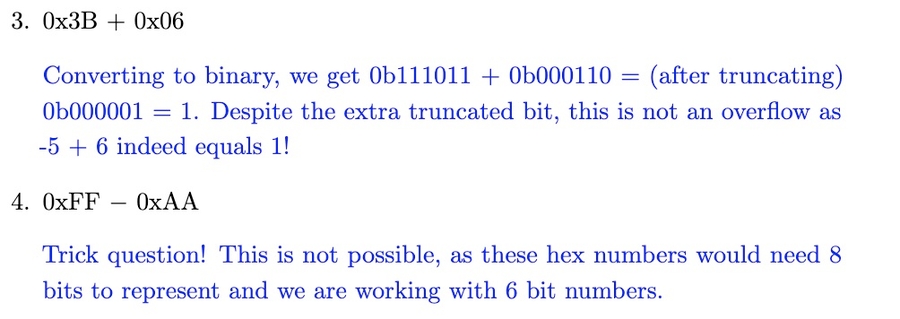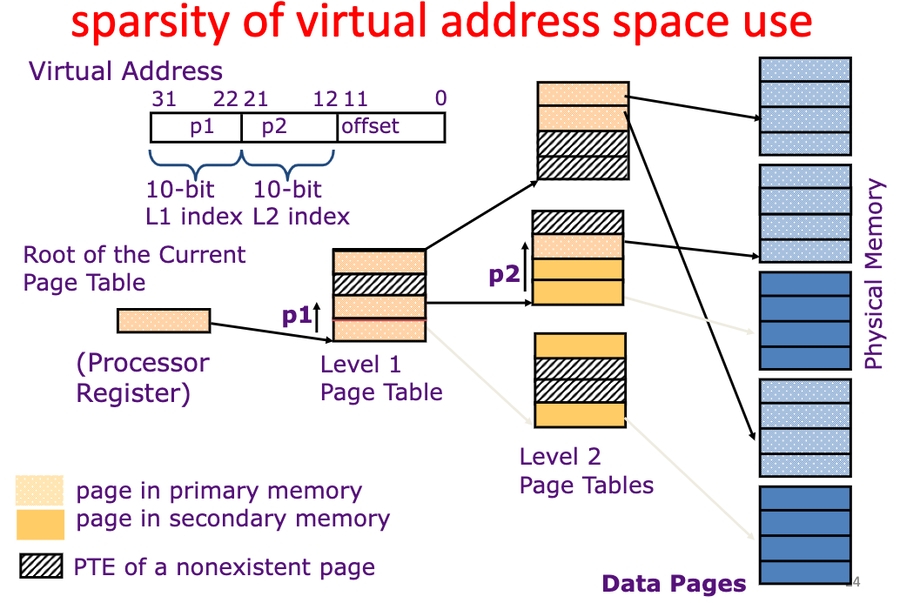CS 110: Computer Architecture I
ShanghaiTech University - Spring 2021
Intro
CA 六大思想
1.Abstraction(Layers of Representation/Interpretation)
2.Moore’s Law (Designing through trends)
3.Principle of Locality (Memory Hierarchy)
4.Parallelism
5.Performance Measurement & Improvement
6.Dependability via Redundancy
其实原版的 CS61C在 21 spring 改成了五大思想(逃)
Numbers
整数
Everything in a computer is a number, in fact only 0 and 1.
Integers are interpreted by adhering to fixed length
Negative numbers are represented with Two’s complement
Overflows can be detected utilizing the carry bit
整数分为 unsigned 和 signed, 对应原码和补码
关于补码的运算和溢出:
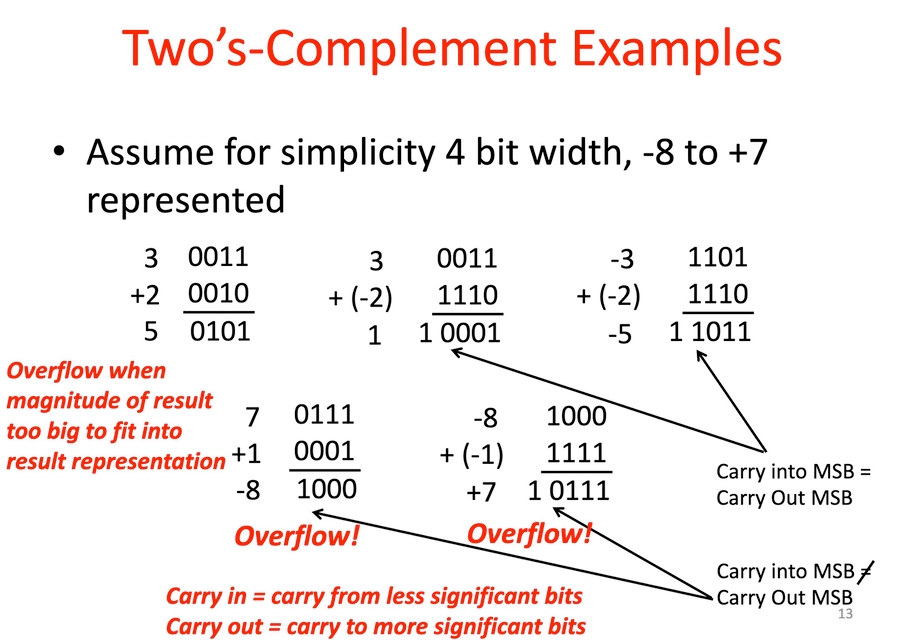
Overflow ERROR: When the result of addition exceeds the range of
Overflow occurs if and only if two numbers with the same sign are added and the result has the opposite sign.
Generally, 负数的二进制值要大于非负数(因为首位二进制为 1)
Unsigned对应A neat trick for flipping the sign of a two’s complement number: flip all thebits and add 1.
2 examples (in 6-bit binary):
The decoding and encoding system are human-defined, so that it can represent any number as wished. That is, no largest interger represent by n-bit numbers
because of
overflown bit represents $2^n$ numbers in binary
2 进制适合计算机, 10进制适合数手指, 16进制表达更方便
Consider
>>operations,for signed int, >> get signed bit;
for neg get -1 (-1 >> 1 = -1)
ref:
IEEE 754 - 计算机数字标准表示
Bias: 偏移, 即在结果加上偏移指, 或者 0b0 代表了偏移值本身. e.g. 0 -> -127, 0xFF = -127 + 0xFF = -127 + 255 = 128 (IEEE 754)
第一位为符号位S。 接下来八位为指数位E,剩下23位为分数位F (32 位)
大小比较:
首先按照指数排序, 再按照尾数排序
64位系统中: 1 位符号位, 11位指数位, 52位小数位 (double)
当指数位
Overflow:
在极大值的情况下会在指数位上溢出
在极小值的情况下会在指数位下溢出
特殊情况:
指数位全0: 极小数
指数位全1, 小数位全0: Infinity 符号根据符号位确定
全0: 0 , 符号位不确定
: 可正可负,指数位全1, 小数位不确定 => NaN
浮点数不精确
NaN 不可比较 (仅仅在 NaN x 时成立)
Smallest Gap:
运算无交换律
最大整数: 0b0 11111110 全1, 因为指数位全1的话会变成 inf
计算方法: e.g. 53.125 =? 110101.001 => => 127 + 5 = 132 = 10000100 => 0 10000100 10101001 000000..
C Simple
Pointers
Dangling references
memory leaks
C 是一个弱类型语言, 也就是说对于每一个类型,结构, 对于其边界没有严格的检查。对于指针也是这样, C将自由和信任交到了程序员手上, 因此会产生很多不安全的内存访问行为。
而 Rua st 则添加了诸多限制。
函数指针:
char *foo(args)
f = &foo能被取地址
(*f)("cat", 3)能被调用, 返回 char*
Tricky:
int* a[10];=> a is an array of pointersint *a, b;=> a is pointer, b is integer
Memory
程序一共有四块内存区
栈:存放局部变量
return address, arguments, local variables
Constants
堆:存放动态变量 - difficult to manage
malloc
calloc
free
realloc
静态:存放 functions 之外的变量
Static variables
Global variables
Constants
String Literals
代码:当程序运行时存储,不可更改
Machine Instructions
Constants
string:
a = malloc(sizeof((char))* strlen(b)+1)pay attention to +1s
strcpy(a,b)不安全, 因为不知道结尾(\0)strncpy(a,b, strlen(b)+1)安全。 if its too short it will not copy the null terminator!
Union
hold different types in the same location
也就是说会存在内存复写
size为最大数据结构的大写, 对齐到 4k , 例如 char 虽然是 1 字节, 但 union 会 size = 4
https://www.geeksforgeeks.org/c-language-2-gq/structure-union-gq/ Q8 is worth doing Q19 helps understanding
#include <stdio.h> #include <string.h> union a{ char b[6]; char c[9]; } data; int main(){ // char d[7]; union a A = {"abcdef"}; strcpy(A.c, "12345678"); printf("%s", A.b); }
#include <stdio.h> #include <string.h> typedef union { unsigned long long num; struct { unsigned short a; unsigned short b; unsigned short c; unsigned short d; } data; } Datatype; int main(){ Datatype y; y.num= 0xABCDDCBADCABAAAA; printf("%d\n", y.data.a); printf("%d\n", y.data.b); printf("%d\n", y.data.c); printf("%d\n", y.data.d); } // result is proved by gcc, clang, msvc on x86 devices [Running] gcc test.c -o test && test 43690 56491 56506 43981 [Done] exited with code=0 in 1.206 seconds >>> 0xABCD 43981 >>> 0xDCBA 56506 >>> 0xDCAB 56491 >>> 0xAAAA 43690 >>>由此可见, 结构体中的类型是自上而下的,而小端序是先下后上的。于是产生了 x 反而对应末尾的2字节。
#include <stdio.h> #include <string.h> typedef union { char d[4]; int e; struct { char a; char b; char c; } data; } Datatype; int main(){ Datatype y; strcpy(y.d, "ABC"); printf("%d\n", y.e); printf("%c\n", y.data.a); printf("%c\n", y.data.b); printf("%c\n", y.data.c); } Result: 4407873 //0x434241 A B Cchar[] 类型或者数组类型也是自上而下的, 因此在内存中从上往下是 'A', 'B', 'C'。 int 按照小端序读是从下往上读,从左往右的拼接数字,所以是 '\0''C''B''A' = 0x00434241 = 4407873(D)
如果感觉自己被加强了,可以试试 3(b)
你正在往 C语言律师的方向上越走越远
cppquiz.com
RISC-V
Instructions
Techniques:
*=-1: 取反加一
寄存器置零: xor zero
函数调用
a0 - a7: arguments
a0, a1: return value
sp: 栈指针
when jal to functions, a0-a7, t0-t6, ra need to save, since they can be modified during callee
jr ra: when some functions is called somewhere, in order to continue running programme, use jr ra to move to ra, and continue programme. 用于返回。 和jal配合使用jal: jumo and link, 给ra赋值, 这样函数就知道回到哪里了j: jal x0 offset 不记录返回值伪指令
Immediates
An I-type instruction can only have 12 bits of immediate
Bits 31:12 get the same value as Bit 11
RISC-V immediates are "sign extended"
首位为符号位
Little Eddiem
小端序:

自下而上的存储, 前面的在下面。 寄存器从下而上数。
0x8f5 为负数(itype 指令只有12位, 因此大于 0x7ff 的都是负数), 因此扩写成16位(因为寄存器为32位)的补码
0xfffff8f5 (两者取反 加一 值相同)
Types
I type只能处理12 bit 立即数LI = LUI + ADDI
DEADBEEF: 如图所示,出现了问题。当且仅当32bit的后12bit为负数时,进行addi操作会扩展成补码。例如
0xEFF会扩展成0xFFFFFEFF。对于前20bit来说, 加上0xFFFFF000无疑等于对第12位取反。解决方法是, 当后三位大于
0x7FF的时候,对第12位+1, 或者是对x10+1。 因为第12位是对于16进制的剩余类,在这个剩余类中,0+F=F, F+1=0, 取反加1为自身。
RISC-V Datapath
Datapath Stage
Instruction Fetch
Send address to the instruction memory (IMEM) and read IMEM at that address.
Instruction Decode
Generate control signals from the instruction bits, generate the immediate, and read registers from the Regfile.
Execute
Perform ALU operations and do branch comparison.
Memory
Read from or write to the data memory (DMEM).
Writeback
Write back either PC + 4, the result of the ALU operation, or data from memory to the RegFile.
不同指令对于不同操作的需求

Latency
Datapath Stage 需要时间, 下表列出了各个指令对应的 Datapath Stage 以及Total Time
在本表中的延时为: IF:200ps ID: 100ps EX: 200ps MEM: 200ps WB: 100ps

critical path: 电路中最长的 Delay Path. 在上表中, 显然 lw是 critical path.
最快: picoseconds = GHz
All in one
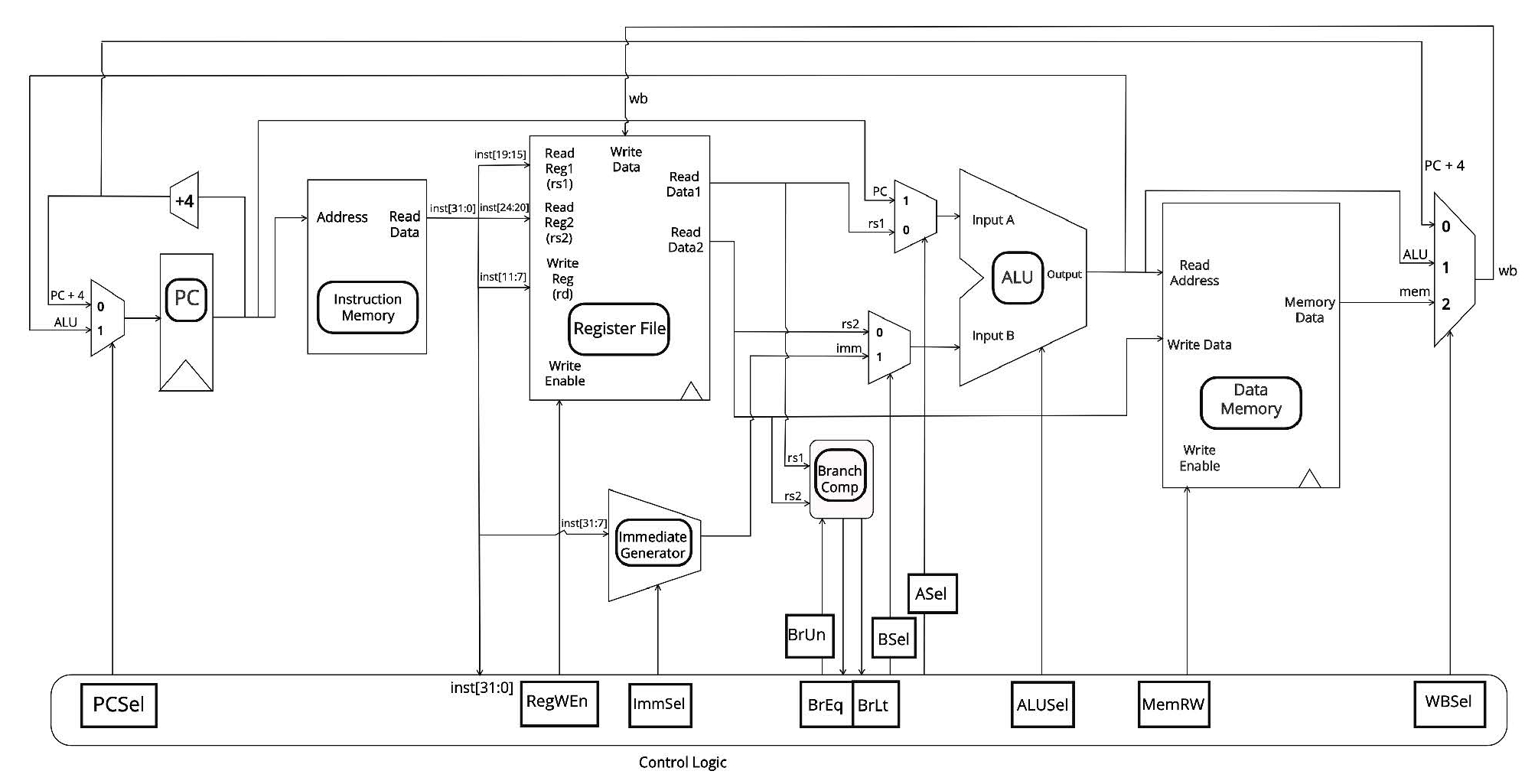
然后根据上表, 把有值的部分画出来就行了
Pipeline (管线)

对单个元件的物理延时无益, 增加整体吞吐率
减少电路元件空置,提高复用率
在每两个 Control 之间加入 Reg 作为 Cache
Hizard
Hizard: prevents starting the next instruction in the next clock cycle (堵马桶)
Structural: A required resource is busy
e.g.
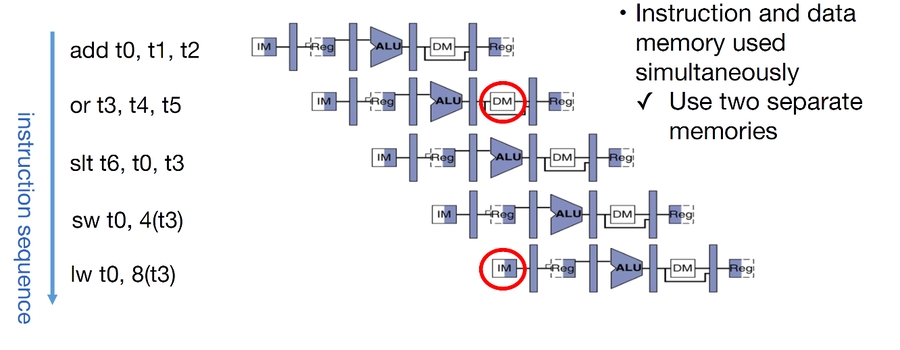
Solution: Use different memory: DM and IM
Duplicate resources
Data:
Data dependency between instructions
Need to wait for previous instruction to complete its data read/write
e.g.
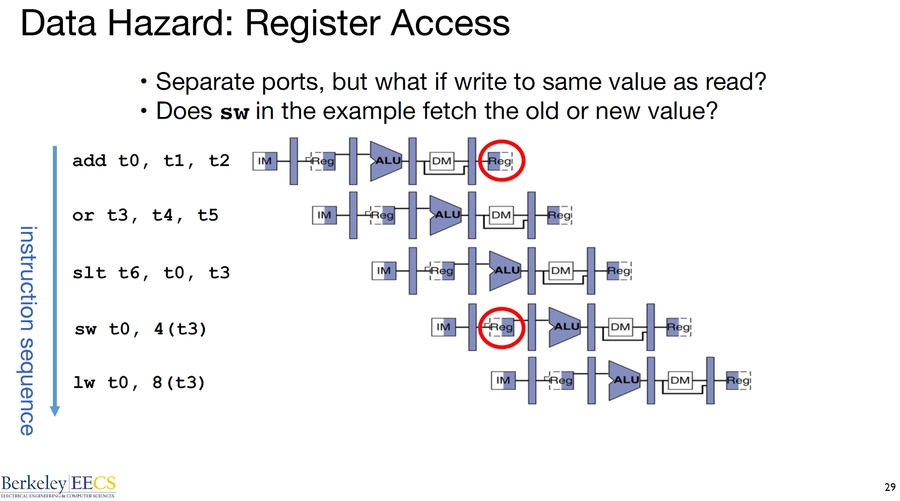
might save
t0of wrong value先读后写( 在图中以左右分色显示 ) —— 不总是成立
当更复杂的情况出现时情况会更糟糕
Solution1: Stalling (降速)

Bubble: Do nothing
Reduce Performance
Just repeat the second (and subsequent) instructions
And insert a "bubble" (noop) into the pipeline
Solution2: Forwarding / Bypassing (搭桥)

注意在 Time 600 附近的蓝色连线
Load:
Stall & 交换顺序
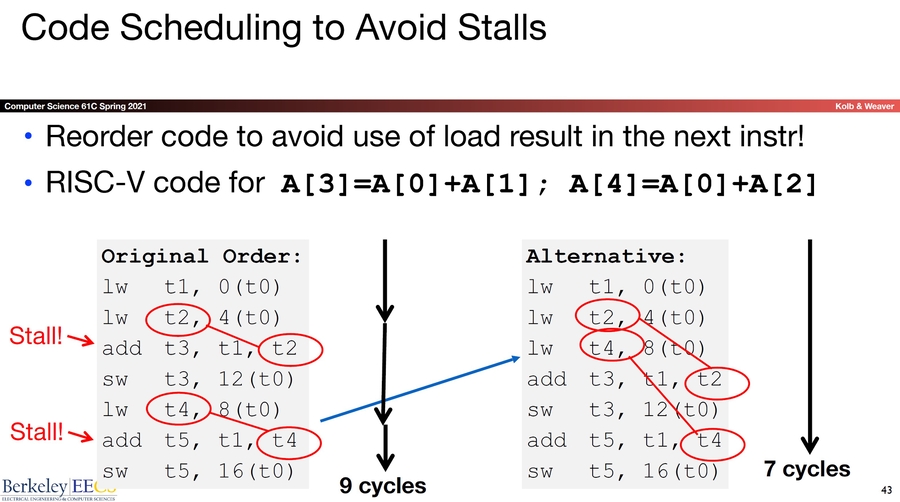
In RISC-V
Only data hazard which requires a stall are when you use data from a load
And only a single cycle
Control
Flow of execution depends on previous instruction
Killing:
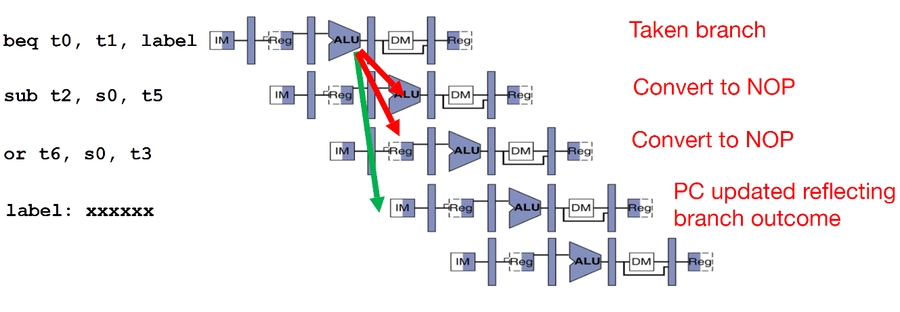
Every taken branch in simple pipeline costs 2 dead cycles
To improve performance, use “branch prediction (分支预测)” to guess which way branch will go earlier in pipeline
Only flush pipeline if branch prediction was incorrect
分支预测:
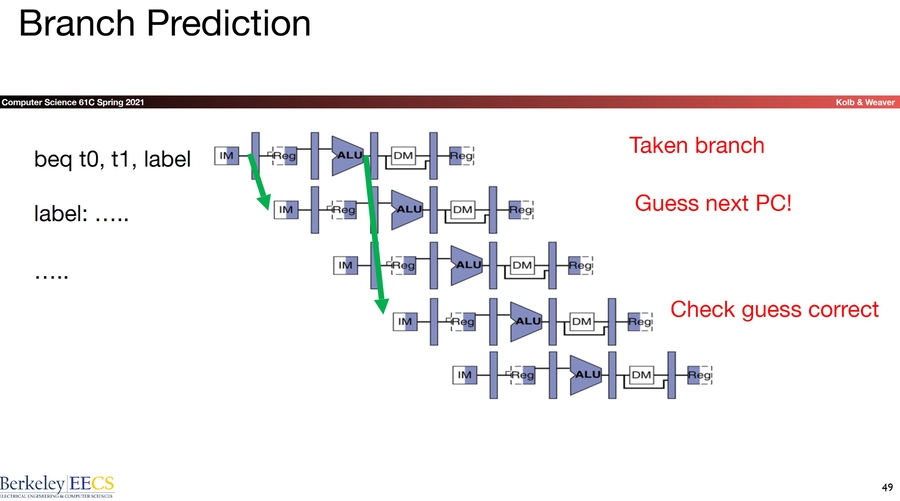
如果这个分支之前走过: 计算
PC + offset然后走如果没有, 继续
PC + 4如果这个分支以前没有见到过: 假设不采用前向分支(forward branches),采用后向分支(backword branches)
最终计算时,使用分支结果更新预测变量上的状态
减少 Control Hazards 出现的概率
Summary:
流水线通过重叠执行多条指令来提高吞吐量
所有流水线阶段具有相同的持续时间
选择适合此限制的部分
Hazards 可能会减少性能
加速加速加速
SuperScalar Processors 将多个执行单元用于额外的指令级并行性
性能优势与代码高度相关
乱序执行
CPI = 1 / IPC
IPC yes
Cache
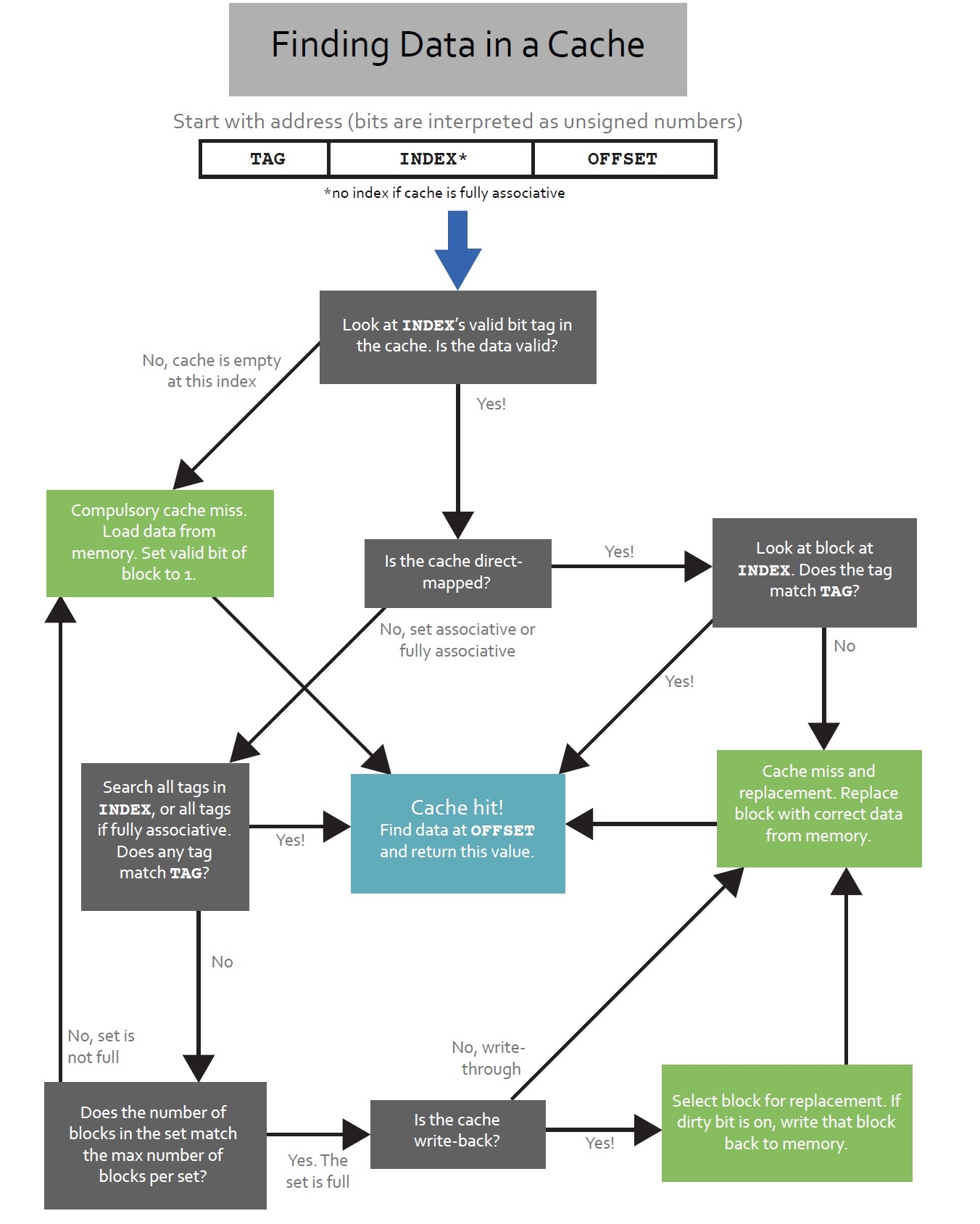
如果没有缓存:
lw t0 0(t1) , find t1 -> 0x12F0 so find Memory[0x12F0] = 99, return to t0
如果有缓存:
Memory[0x12F0] = 99 这步会快
我们这么定义:
Memery[Tag] = Data
OS
Boot
在某个内存位置开始执行指令
BIOS: 查找一个存储设备并加载第一个扇区(数据块)
后继者 UEFI : 现代,友好,复杂
Bootloader: 从磁盘将OS内核加载到内存中的某个位置,然后跳入该位置。
OS Boot: 初始化服务、驱动程序等
Init: 启动一个等待输入循环的应用程序 (e.g. Terminal, Desktop )
IO
轮询:
在到设备的总线上通常有两个寄存器: 控制寄存器(0/1, r/w)和数据寄存器
当控制寄存器为 1 时设备可用
此时CPU从数据寄存器中读取数据,并复位控制寄存器为0
该过程称为轮询(Polling), 为了避免IO wait
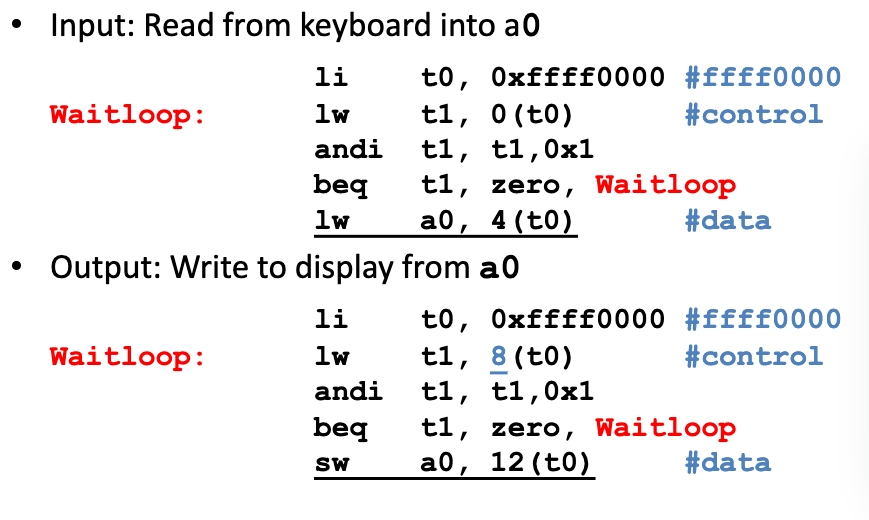
计算轮询的时间占比:
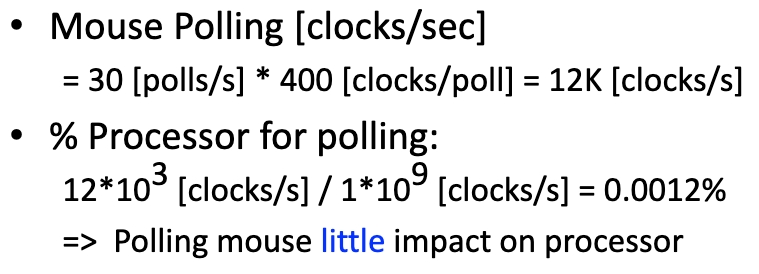
Interrupt-driven
在运行程序时,发现IO就绪,此时中断程序(Suspend),将CPU用于IO处理
方法: 插针(jalr)
术语
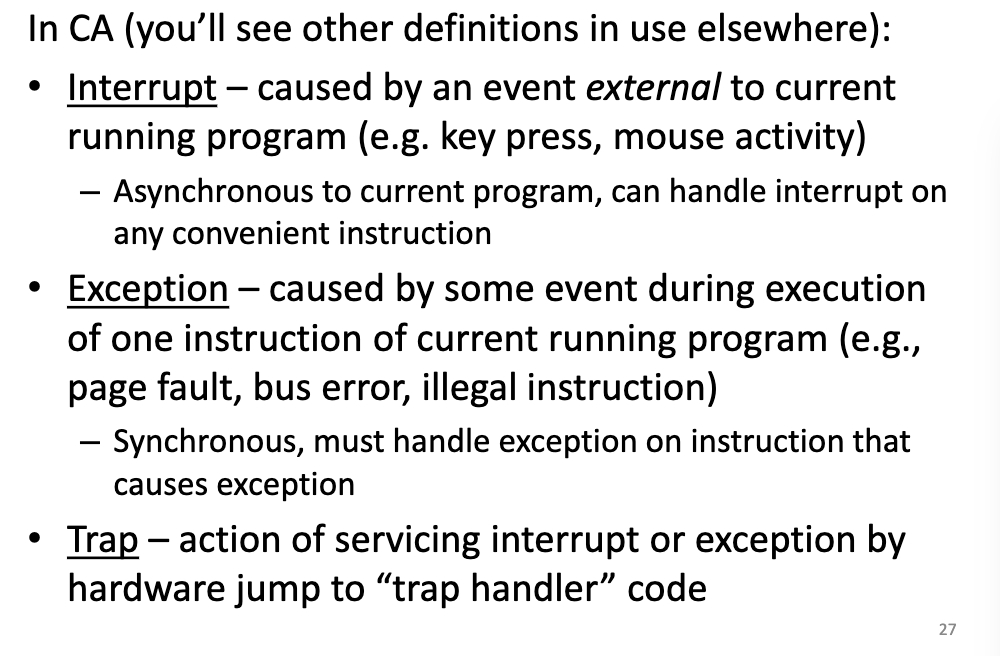
Interupt - 异步
Exception - try
Trap - Except
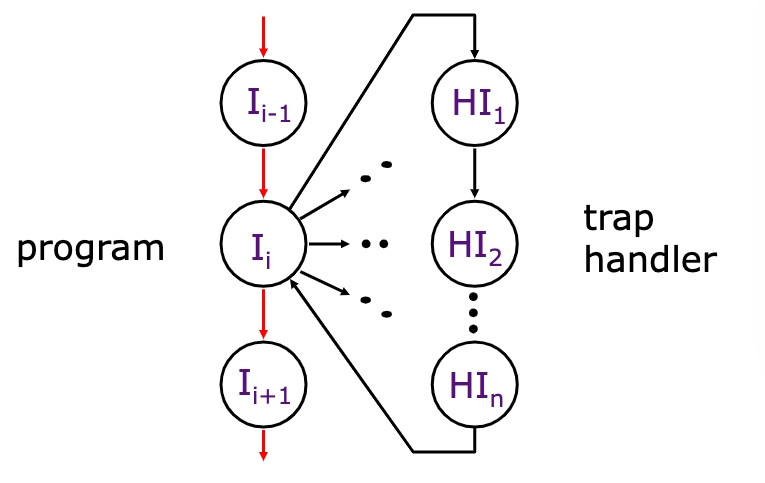
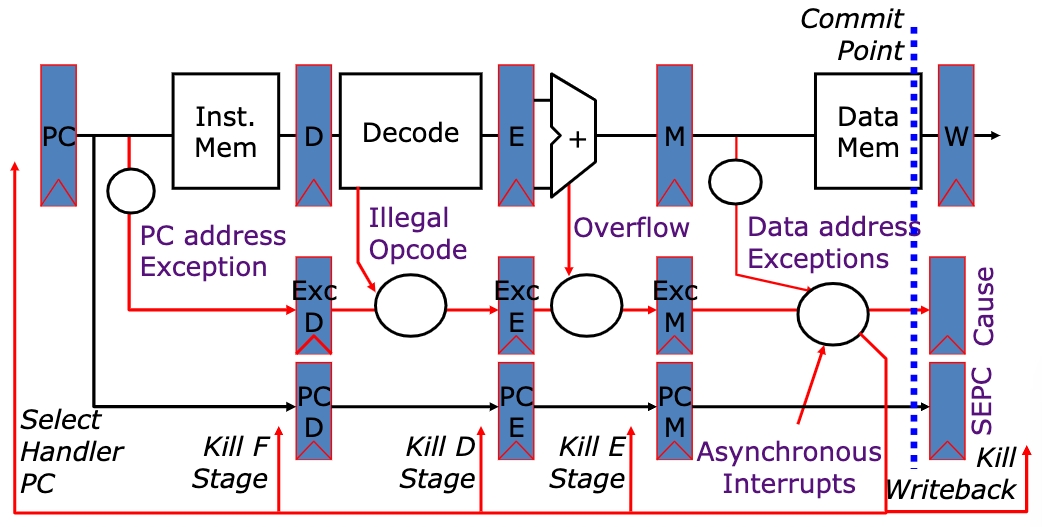
为Pipeline增加了鲁棒性,通过在每一个cache中加入 exception 的方式
Precessed
syscall and fork
通过 sys call 来完成大部分任务和函数,以及资源的调用,这一步由操作系统代劳
Supervisor
访问部分物理内存
Scheduling
快速切换上下文, 并为每个程序设置时间,来保证绝大部分程序能分配到差不多的执行用时
而快速切换上下文的技术可以快速的转移程序的执行
Virtual Memory
虚拟内存空间 通过 操作系统 对 物理内存空间的 映射
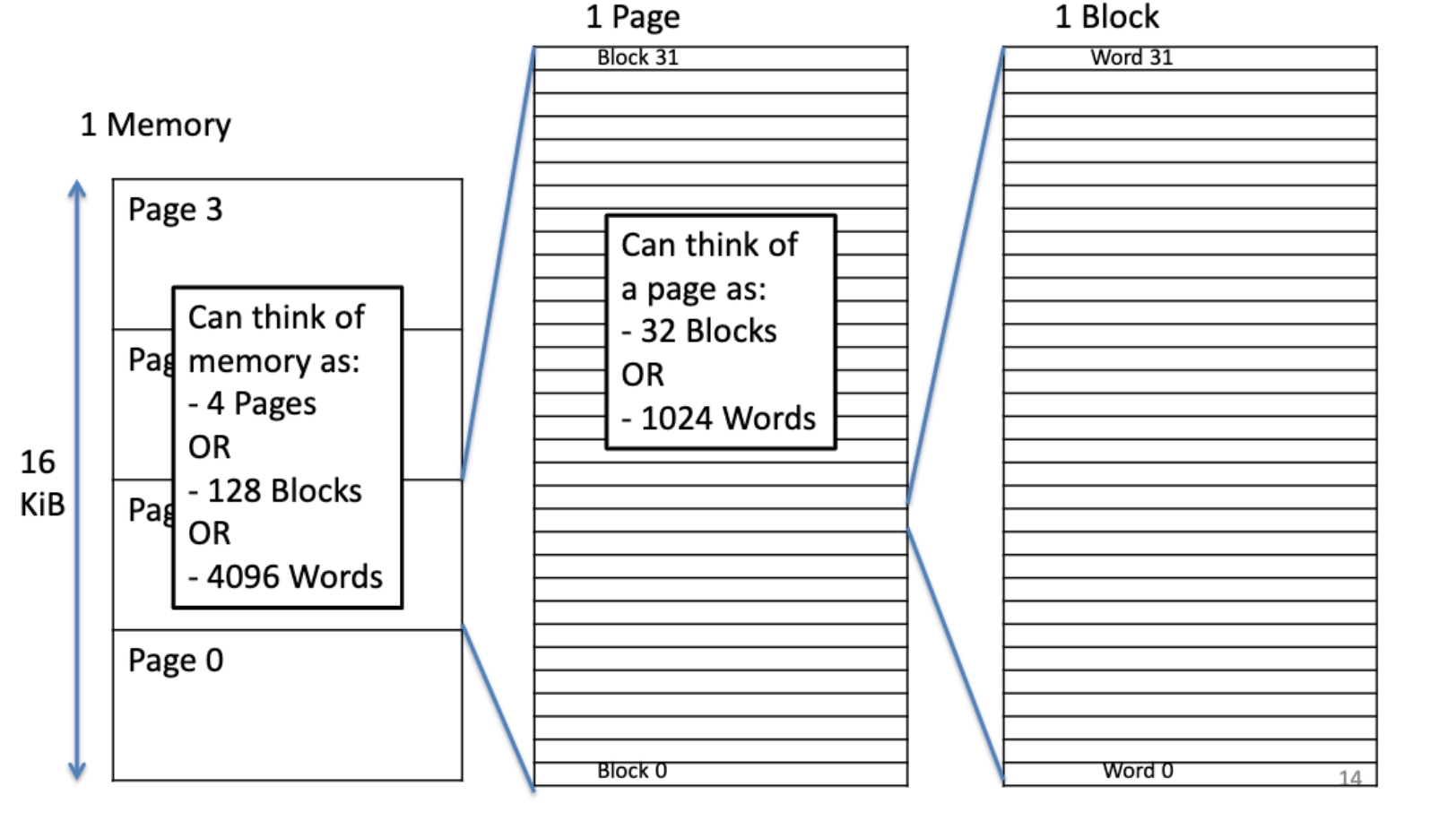
物理内存为页 (Pages)的集合
页为块(Blocks)的集合
块为一段字节(Word)
所以给每个用户分一个页(或者页表), 页是对内存块的标记
页表保存在MEMORY中

内存管理
线性页表
1位检查是否页表存在
PPN: 内存页
DPN: 磁盘页
状态位: 读/写
只要活动的用户进程发生更改,操作系统就会设置页面表基本寄存器
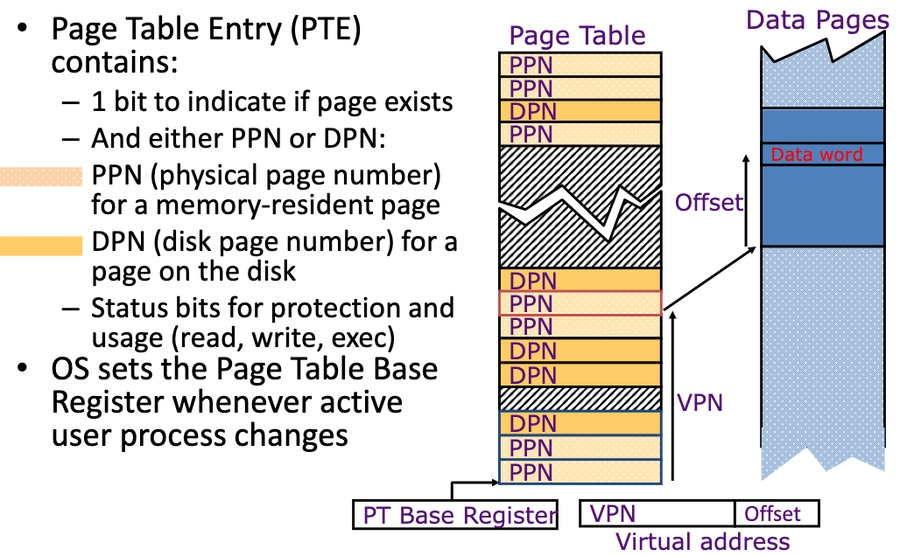
错误处理:
不存在 -> 分配一个新的
大小
分级页表
虚拟内存便于检查,并且有效率
在页表中有时候会做虚拟地址到物理地址的缓存(Translation LookasideBuffers )
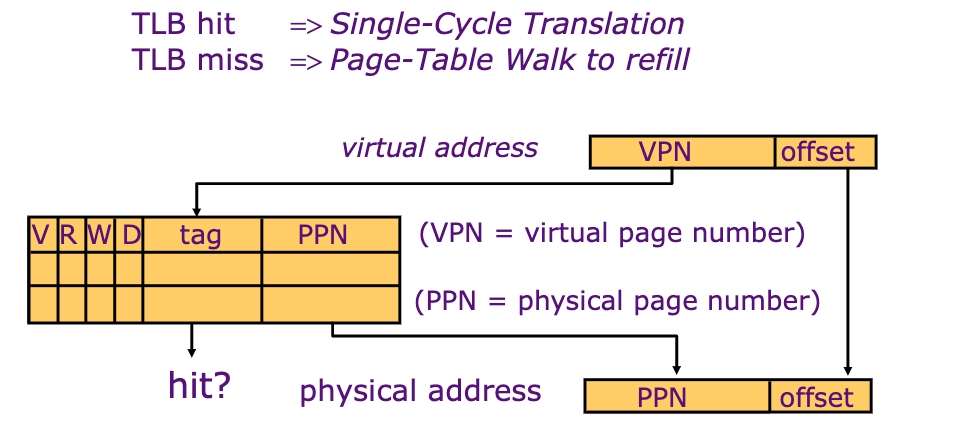

REF
Last updated
Was this helpful?
